
The Coronado Expedition in Texas
The Coronado Expedition in Texas
- Introduction
- The Quest for Quivira
- The Llano Estacado
- Bison
- The Querechos and Teyas
- Cabeza de Vaca's Party
- The Jimmy Owens Site
Next: Coronado Expedition Route Analysis
Introduction
Between 1540 and 1542, Spanish explorer Francisco Vázquez de Coronado led an expedition that explored a section of the United States, including parts of Arizona, New Mexico, Texas, Oklahoma, and Kansas. Coronado began his expedition searching for a city called Cibola, which was reported to be in a land of seven cities of gold. He arrived at Cibola and found no gold, but he kept exploring. Near present-day Albuquerque, he received a report of a distant land known as Quivira - another supposed province of cities of gold and silver. Coronado set out to find this land of great wealth.
Coronado's quest for Quivira took him across the northern regions of Texas in 1541. He and his men described many of the motifs of the American West of yesteryear: the empty plains known as the Llano Estacado, the ravines of the Caprock Escarpment, the bison that roamed the plains, and the native tribes that followed and hunted the bison.
The most comprehensive first-hand account of Coronado's journey was written by Pedro de Castañeda, a soldier in Coronado's army. Another soldier, Juan Jaramillo, wrote a briefer, yet well-organized, account that adds to the information given by Castañeda. Additional details are found in letters written by Coronado himself and documents written by other persons, some anonymous. All of this material was compiled and translated to English by George Parker Winship in The Coronado Expedition 1540-1542, published in Washington, D.C. in 1896.
This article focuses on the Coronado Expedition's presence in present-day Texas. The rest of the expedition is only summarized briefly.
The Quest for Quivira
The Coronado Expedition was organized and financed chiefly by Coronado himself and by Antonio de Mendoza, the viceroy of New Spain, on the basis of reports of large native settlements in the wilderness to the north of Spain's existing claims in present-day Mexico. The first of these reports came from the testimony of four men who traveled across present-day Texas and northern Mexico in 1535 and 1536. These men - Spaniards Álvar Núñez Cabeza de Vaca, Andrés Dorantes, Alonso del Castillo, and Dorantes's Moor slave, Estevanico - were shipwrecked on the Texas coast in 1528 with about 200 other members of the failed Narváez Expedition to Florida and were the only ones to return to Spanish civilization. They told Viceroy Mendoza that during their travels, some of the natives they stayed with gave them a copper bell, which came from a village further north where copper was plentiful and the natives knew how to smelt and forge it. Mendoza sent Marcos de Niza, a Franciscan friar, into this wilderness in 1539, with Estevanico as his guide. They got as far as a large town called Cibola. Estevanico, who had gone ahead of Friar Marcos, was killed by the natives of Cibola. When Marcos found this out, he was afraid to get too close, so he only saw Cibola from a distance. Nevertheless, Marcos's report seemed to confirm what everyone wanted to believe: that in this tierra nueva, or "new land," there was a province with seven cities of gold, one of which was Cibola.
While it may seem obvious to us today that the Spaniards' belief that they were going to find cities of gold in the southwestern United States - or anywhere else - was outlandish and foolish, one must remember that in 1519, Hernán Cortés did discover a city of gold: the Aztec city of Tenocthitlan - present-day Mexico City. In 1526, Francisco Pizarro discovered the even more wealthy Inca land of Peru. To the Spaniards in the New World in 1540, the question was not whether large native cities full of gold and other treasures could exist; the question was when and where they were going to find the next one.
Coronado's expedition officially launched from Compostela, in present-day Nayarit, Mexico, on February 23, 1540. In July, Coronado found Cibola in present-day New Mexico, near the New Mexico-Arizona state line. It was smaller and much less impressive than he was expecting, and it contained no gold. Coronado's men vented so many curses upon Friar Marcos that he had to go back to Mexico, fearing for his own safety. Coronado conquered the town and then sent captains out to explore the neighboring provinces, because there was still hope that the cities they were looking for were out there. After all, Marcos had merely corroborated (and possibly enhanced) other reports that had been going around for a while. Just because he was wrong about Cibola being a city of gold did not mean there were not cities of gold somewhere else.
While the Spaniards were still at Cibola, trying to figure out their next move, some natives came from a province called Cicuye to welcome them. Their leader had a long mustache, so the Spaniards called him Bigotes, the Spanish word for mustache or whiskers. Bigotes guided a company of Spanish soldiers led by Captain Hernando de Alvarado to a province called Tiguex, a group of about a dozen villages on the Rio Grande north of present-day Albuquerque, near Bernalillo. Finding Tiguex to be a good place to set up a camp, Alvarado sent messengers back to Coronado to advise him to bring the army there.
Next, Bigotes took Alvarado another five days northeast to Cicuye, which was on the Pecos River, southeast of present-day Santa Fe. There Alvarado met an Indian who the natives of Cicuye were holding captive. Castañeda wrote that this Indian was from an unknown land "of the country toward Florida,"1 which was what the Spaniards called the entire southeastern United States. The Spaniards called him The Turk "because he looked like one."2 The Turk told Alvarado that he knew of a land where there were many large villages full of gold and silver. Alvarado took The Turk with him back to Tiguex to await Coronado and give him the exciting news.
When The Turk met Coronado, he told him about the rich country of Quivira. He said that the ruler of Quivira slept under a tree on which a great number of little gold bells were tied, which tinkled him to sleep as the branches moved. He also said that the jugs and bowls from which everyone ate were made of wrought gold, and the river contained fishes as big as horses.
It was unfortunate for the natives of Tiguex, who were called Tiwa, that the Spaniards arrived in their province in autumn, for as eager as the Spaniards were to let The Turk take them to Quivira, winter was coming. Travel was always more difficult in winter, especially for people from warm climates. Food was harder to find, the need for clothing, shelter, and firewood was greater, and snow and ice made marching more difficult. The Spaniards postponed their journey until the spring. In the meantime, they expected the Tiwa to furnish them dwellings, food, and clothing. The Tiwa were happy to do this at first, as a gesture of friendship to travelers, but not on a continuing basis for men who would not leave and who did nothing to support themselves. Furthermore, the Spaniards seized Bigotes and another leader of Cicuye for allegedly hiding gold from them, and at least one Tiwa woman was raped. The Tiwa rebelled, and the Spaniards spent the winter of 1540-1541 waging war against them. The Tiwa ultimately had to flee to the mountains.
When spring finally came, Coronado marched his army out of Tiguex. His first stop was Cicuye, where he returned Bigotes to his people. Bigotes and the chief of Cicuye gave Coronado a guide named Xabe, who was from Quivira. Xabe told the Spaniards that there was gold and silver in Quivira, but not as much as The Turk had said. Another native of Quivira, named Ysopete, told Coronado that The Turk was lying and should not be trusted. The Turk stuck to his story and advised Coronado to pack the horses lightly, because they would need their strength to carry back all the gold and silver he would find. Coronado chose to listen to The Turk and let him guide his army to Quivira, but he brought the other guides as well.
Leaving Cicuye, the Spaniards crossed a river and then entered some plains that seemed to go on forever. These plains were inhabited by immense herds of bison and by natives called Querechos who followed and hunted the bison. The Querechos did not know of Quivira, so Coronado continued to let The Turk guide his army. Little did he know, but The Turk was not leading him to Quivira. Instead, he was taking Coronado and his men toward his home country, in the direction of Florida.
It took almost a month for the army to cross the plains. The Spaniards eventually found some ravines and camped in them. In that area, they met some natives called Teyas, who followed and hunted the bison just like the Querechos, but were enemies with them. The Teyas knew about Quivira. They said it was not nearly as large or grand as The Turk had made it out to be, and they were not going the right direction, for they had been traveling east, while Quivira was to the north, more than 40 days away. Everything they said corroborated what Ysopete had been telling Coronado about Quivira and The Turk's untrustworthiness. Coronado had come this far, though, and could not take a chance on passing up his opportunity for wealth. He decided to park the main part of his army in the ravines and continue on to Quivira with thirty men on horseback. The Turk, who Coronado had lost confidence in, was placed in chains, and Ysopete took over as the main guide.
A few days after leaving the ravine, Coronado sent messengers back, ordering his army to regroup and wait for him at Tiguex. After about six weeks, he and his company reached Quivira, which was in central Kansas. Like Cibola, Quivira was a bust - nothing like The Turk had described, and nothing like the Spaniards had hoped for. The villages were small, the houses were crude, and while there was some copper, there was not a lot of it, and there was no gold or silver. The Turk then confessed that he had been trying to get the Spaniards lost so that they would die on the plains, He said that the natives of Cicuye put him up to this deception as revenge for treating them so poorly. Coronado had The Turk garroted for his treachery.
Despite his disappointment with Quivira, Coronado was nevertheless impressed with the agricultural productivity of the land. He thought it might be worth placing a settlement there, but by the time his little exploratory party regrouped with the main army back at Tiguex, it was October and, once again, too late in the year to travel. The plan to return to Quivira and place a settlement there was postponed until the spring.
Morale in the camp during the winter of 1541-1542 was poor. Not only had the expedition been a huge disappointment so far, but good clothing was getting scare, the men had lice, and the natives were unhelpful. Some men complained that others were receiving preferential treatment in the distribution of rations and work assignments. Then, one day while Coronado was amusing himself with a friendly race against one of his captains, his saddle cinch broke. He fell off his horse, and the horse struck his head with its hoof while it was still running. Coronado was severely injured. Believing he might die soon, he wanted to return home to see his wife first. According to Castañeda, Coronado secretly had certain men spread the idea that the expedition ought to end. His captains then presented a signed petition requesting for the army to return to New Spain. Coronado signed it under feigned protest, and then the march home began. He made a full recovery on the way back.
Coronado's expedition greatly expanded Spain's knowledge of the North American continent, but because it found no gold and did not establish any new colonies, it was considered a complete failure at the time.
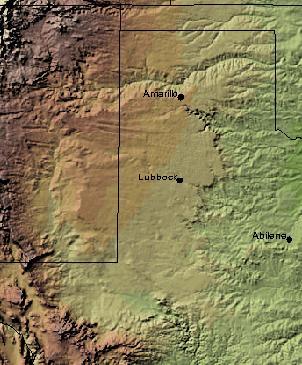
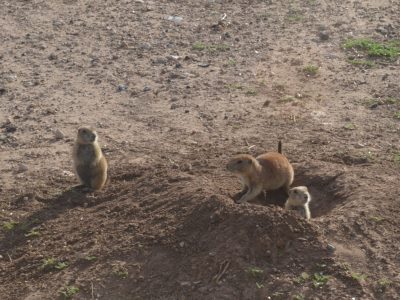
The Llano Estacado
Historians have long known that Coronado passed through Texas because of his and other witnesses' descriptions of the flat, featureless prairie between Cicuye and Quivira. Coronado himself was the first person to leave a written description of the region geographers call the Llano Estacado:
I reached some plains, so vast that I did not find their limit anywhere that I went, although I traveled over them for more than 300 leagues ... I reached some plains, with no more landmarks than as if we had been swallowed up in the sea, where they [the guides] strayed about, because there was not a stone, nor a bit of rising ground, nor a tree, nor a shrub, nor anything to go by.3
Due to the curvature of the Earth, When a person is standing on a hill or a tall structure, he can see further than when he is standing on the ground. By the same token, when he is standing on the ground, he can see hills, trees, tall buildings, and other features of the landscape even though they are far away. When he is standing on the ground, however, and there are no tall features he can see, his vision is limited to the ground in a three-mile radius around him - everything else is sky. Similarly, if there is no land in sight, a man standing on the deck of a ship cannot see anything but a few miles of water in every direction. This is what Coronado meant when he compared the plains to being "swallowed up in the sea." Castañeda wrote that the plains were "like a bowl, so that when a man sits down, the horizon surrounds him all around at the distance of a crossbow shot."4
Castañeda also wrote about the great difficulty the Spaniards had finding their way around this endless, empty landscape. Not only were there no landmarks, but a man or company of men could not even retrace their own steps in the grass, because it was short and always straightened back up after being walked upon. This "buffalo grass," as it is now called, is a popular turf grass in dry areas because it remains less than 12 inches tall even if it is never mowed. To keep from getting lost on the plains, the Spaniards made piles out of stones mixed with cow dung. Despite taking this precaution, when the Spaniards left the ravine where they were camping to hunt, many men got lost for two or three days, "wandering about the country as if they were crazy, in one direction or another, not knowing how to get back where they started from."5 The men in the camp fired guns, blew trumpets, beat drums, and built great fires to help the hunters find their way back. Castañeda wrote that the natives made their way across the plains by shooting an arrow in the direction they wanted to go and walking toward the shaft sticking out of the ground. Before they reached the arrow, they would shoot another one past it, using the first one to aim by.
In addition to bison, the animals the Spaniards saw on the Llano Estacado included wolves, deer, and rabbits. The rabbits, Castañeda wrote, would flee from a person on foot, but not from a man on a horse, making it easy to kill them with lances from horseback. They also saw "large numbers of animals like squirrels and a great number of their holes,"6 i.e., prairie dogs.
The Llano Estacado can easily be seen in the map in Figure 1 at right. It covers the northwestern part of Texas and the eastern side of New Mexico, stretching about 100 miles west and about 50 miles east of the Texas-New Mexico state line. It is bounded on the north by the Canadian River, which runs west-to-east across the Texas Panhandle north of Amarillo. The Caprock Escarpment, a long cliff approximately 300 feet high, is where the Llano Estacado transitions into rolling plains. The Texas cities of Amarillo, Lubbock, Midland, and Odessa are on the Llano Estacado.
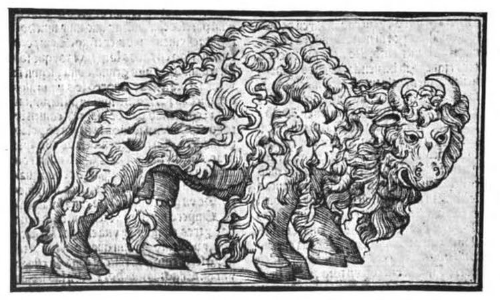
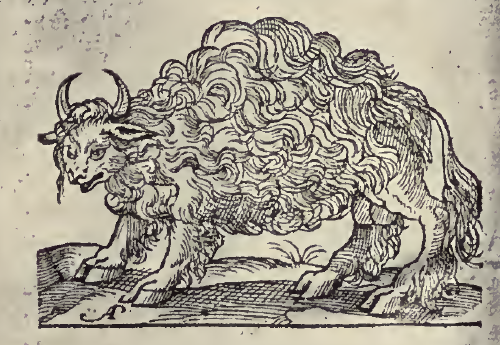
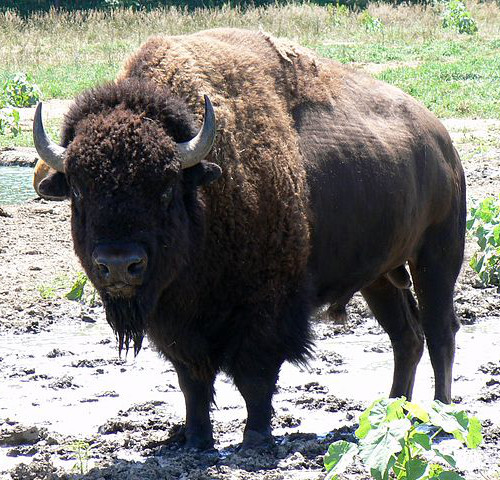
Bison
All of the witnesses reported seeing huge roaming herds of bison, which they called "cows," and which are also commonly called buffalo. Álvar Núñez Cabeza de Vaca, one of the four survivors of the Narváez Expedition, gives us the earliest written description of these animals, but Castañeda's description is longer and more thorough. In part, it reads:
Now that I wish to describe the appearance of the bulls, it is to be noticed first that there was not one of the horses that did not take flight when he saw them first, for they have a narrow, short face, the brow two palms across from eye to eye, the eyes sticking out at the side, so that, when they are running, they can see who is following them. They have very long beards, like goats, and when they are running they throw their heads back with the beard dragging on the ground. There is a sort of girdle round the middle of the body. The hair is very woolly, like a sheep's, very fine, and in front of the girdle the hair is very long and rough like a lion's. They have a great hump, larger than a camel's. The horns are short and thick, so that they are not seen much above the hair. In May they change the hair in the middle of the body for a down, which makes perfect lions of them. They rub against the small trees in the little ravines to shed their hair, and they continue this until only the down is left, as a snake changes his skin. They have a short tail, with a bunch of hair at the end. When they run, they carry it erect like a scorpion. It is worth noticing that the little calves are red and just like ours, but they change their color and appearance with time and age.7
Castañeda also observed that when the Spaniards first saw the bison, they went for over 100 miles, seeing countless numbers of bulls without a single female member of the species among them. The explanation for this is that the Spaniards arrived in bison country in May, which is calving season, and the bison bulls were forming a protective circle around the cows and their newborn calves.
Coronado did not describe the bison's appearance, but he did remark about how numerous they were. "I found such a quantity of cows ... which they have in this country, that it is impossible to number them, for while I was journeying through these plains, until I returned to where I first found them, there was not a day that I lost sight of them."8 Another witness wrote, "There is such a quantity of them that I do not know what to compare them with, except with the fish of the sea ... there were so many that many times when we started to pass through the midst of them and wanted to go through to the other side of them, we were not able to, because the country was covered with them."9
Although the huge herds of roaming bison are gone now, the section of the Llano Estacado that the Coronado Expedition crossed - approximately the northern half, between Amarillo and Lubbock - remains an excellent country for supporting large numbers of cattle. In 2012, six of Texas' ten counties with the largest cattle population were in this region.
The Querechos and the Teyas
The members of the Coronado Expedition met two tribes of natives on the Llano Estacado: the Querechos, who lived closer to Cicuye, and the Teyas, who lived closer to Quivira. Both tribes were nomadic and roamed with the bison herds, which they depended upon for everything. Not only did they eat their flesh, often raw, but they also drank their blood. For this, they would make a canteen from one of the bowels, fill it with blood, and place it around their necks. They even drank the bison's stomach juice, squeezing it out of the chewed grass. They used the hides to make clothing and tent coverings. For what little they needed that they could not get from the bison, they would go to the settlements, such as Cicuye and Quivira, in the winter and trade their bison hides with the other natives.
Castañeda does not make any distinctions between the Querechos and the Teyas, other than their areas of habitation, and implies that they were different subsets of the same race and culture. They were well-built, attractive-looking, and well-dressed. The Spaniards considered them to be very intelligent because they were able to make themselves completely understood through sign language. They saddled their dogs and used them to carry their belongings and pull their tents behind them with poles. They were friendly and did not engage in practices the Spanish considered offensive, such as cannibalism or idolatry.
In 1601, Juan de Oñate led another expedition to the area east of Cicuye area. He met the Querechos and gave them the name they are better known by: Apaches. The amiable relations between Coronado's men and the Querechos did not exist in later generations, for conflict between Apaches and Spaniards was almost incessant in the 18th century.
The identity of the Teyas is an unsettled question, because neither Oñate nor any subsequent group of Europeans encountered them again. Based on the texts' indication that the Querechos and the Teyas were two groups of the same people, however, it seems likely that the Teyas were also Apaches, for the name Apache is actually a collective reference to a couple of dozen or so individual tribes.
The name Teyas has invited some speculation. About 150 years after Coronado, some Spaniards called a tribe of Caddo Indians "Tejas," which sounded like the Caddo word for "friend." Possibly, the question was asked, "What do you call your neighbors?" and the answer was given, "friends." The men who wrote about the Coronado Expedition do not explain how they came to call the natives of the plains Teyas, so whether or not it has the same etymology as Tejas, or whether the similarity between their names is merely a coincidence, is unknown.
Cabeza de Vaca's Party
When Coronado's party came to the ravines, and apparently before they met the Teyas, they met a group of Indians who told them about a previous party of Spanish explorers. Jaramillo writes:
"There was an old blind man with a beard, who gave us to understand, by signs which he made, that he had seen four others like us many days before, whom he had seen near there and rather more toward New Spain, and we so understood him, and presumed that it was Dorantes and Cabeza de Vaca and those whom I have mentioned."10
Jaramillo's conclusion (or presumption) that the four men who the blind bearded man remembered were Cabeza de Vaca's party is sound, and not just from his description of them as "four others like us." In their written accounts of the Narváez Expedition, Cabeza de Vaca and his companions stated that they usually returned most of the gifts that the natives offered to them, taking only whatever food they needed and the occasional trinket for themselves, but giving all the rest back. Furthermore, the natives, who regarded Cabeza de Vaca and his companions as "children of the sun," always insisted that they bless them, touch them, bless their food, bless their children, and even heal their sicknesses. Castañeda writes that these natives who remembered Cabeza de Vaca's party offered a pile of skins to Coronado's men, and then were stunned and saddened when Coronado took them and divided them among his men. "They thought," Castañeda writes, "that the strangers were not going to take anything, but would bless them as Cabeza de Vaca and Dorantes had done when they passed through here."11
Jaramillo's statement that the natives had seen Cabeza de Vaca's party "near there" and Castañeda statement that they "passed through here" can be misleading. Cabeza de Vaca's party of four survivors escaped from their Indian captors in present-day south Texas, went south across the Rio Grande, then turned their journey northwest so that they re-crossed the Rio Grande in west Texas. They followed that river's north bank up to El Paso and then crossed it again into New Mexico and northern Mexico. They never entered the Llano Estacado and never went within 300 miles of Blanco Canyon. (For our analysis of Cabeza de Vaca's party's route across west Texas, see our article, The Narváez Expedition in West Texas.) Jaramillo, however, does not tell us directly that Cabeza de Vaca's party passed near there; quite on the contrary, he said the old blind man communicated with them through signs, as opposed to through an interpreter,12 that this is what the Spaniards understood him to say, and even then, the location of meeting seemed to be "rather more toward New Spain," i.e., Mexico. Castañeda does more succinctly state that Cabeza de Vaca's party "passed through here," but that is probably a further misunderstanding. When Coronado's army was on the march, Coronado usually had an advance guard go in front of the main body. The natives who told the Spaniards about Cabeza de Vaca's party were found by this advance guard, which was then under the command of Captain Rodrigo Maldonado. The perspective of each of the writers suggests that Jaramillo was with Maldonado's company at the time, while Castañeda was with the main army. It appears that by the time the old blind man's news reached Castañeda, the revelation that, as best as they understood, Cabeza de Vaca's party had been "seen near there and rather more toward New Spain," had been simplified to "they passed through here."
If it is true that Cabeza de Vaca's party stayed near the Rio Grande and Indians in Blanco Canyon remembered seeing them, that means those Indians were either visiting Blanco Canyon when Coronado's men came through, were visiting the Rio Grande when Cabeza de Vaca came through, or both. This would not be all that unusual. Both the Coronado and Cabeza de Vaca expedition records tell of natives who traveled hundreds of miles either for trade or to visit seasonal feeding grounds.
There is one more interesting piece of information Coronado's men observed about the natives who remembered Cabeza de Vaca's party. Castañeda notes, "they found a female here who was as white as a Castilian lady."13 This implies that Cabeza de Vaca and his Spanish companions sowed their seed with the natives.14 Cabeza de Vaca and his companions never report having any unchaste interactions with the natives during their seven years in Texas, but their accounts do have a few intriguing hints to that effect, such as a statement by Cabeza de Vaca that each of one of the four slept in a separate hut with "all of his company."
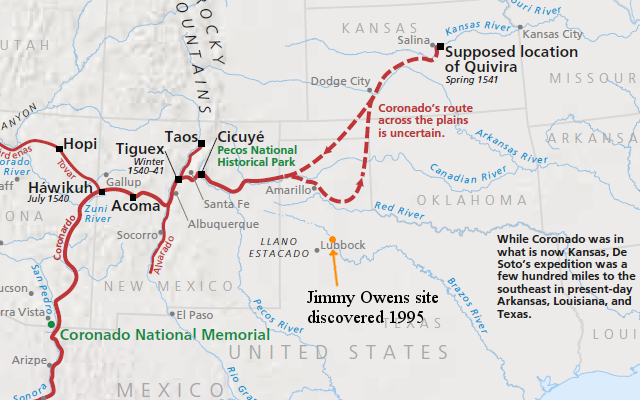
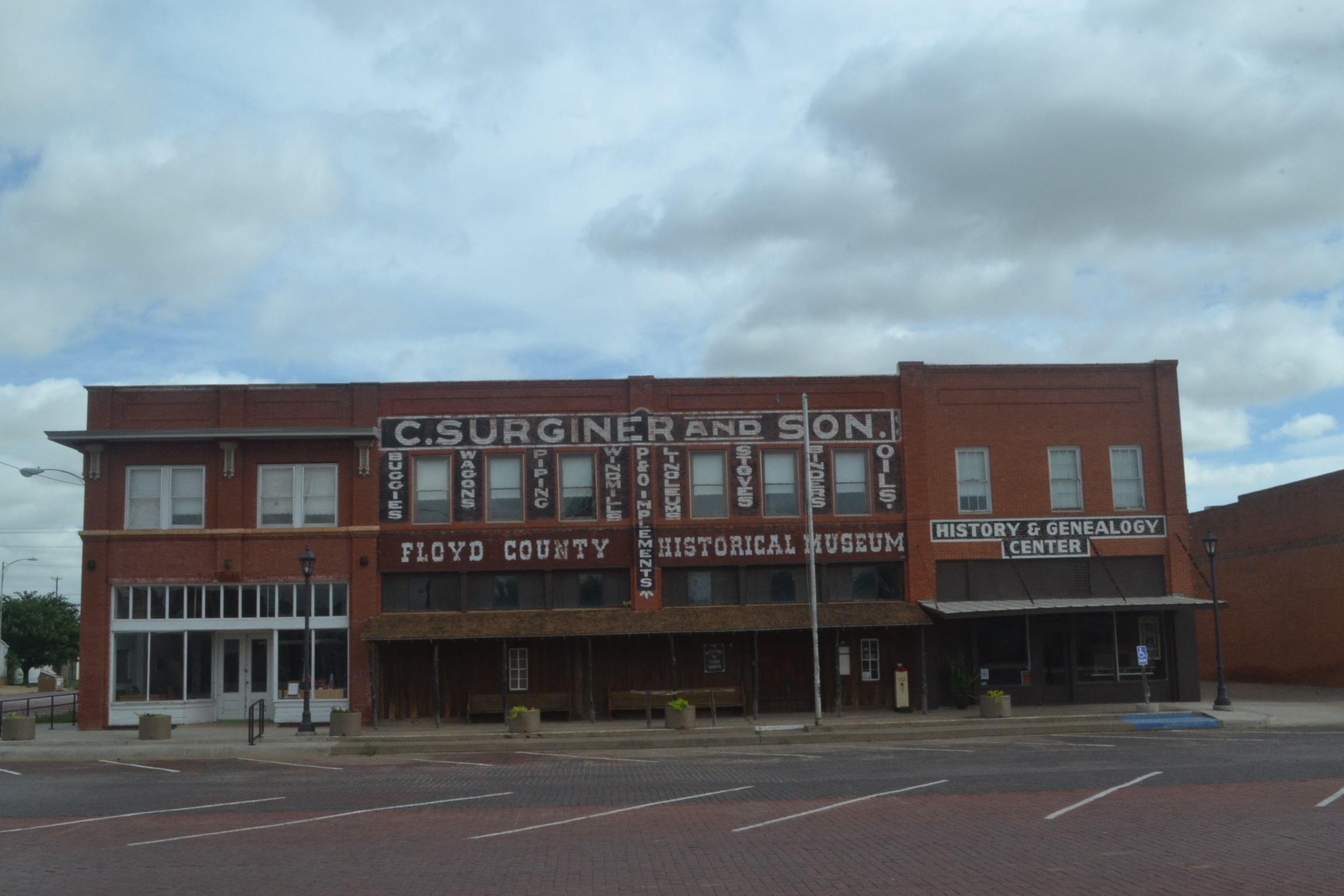
The Jimmy Owens Site
Until recently, the route that the Coronado Expedition took across the Llano Estacado was poorly understood. In general, the texts indicate that the men traveled in a mostly easterly direction and descended the Caprock Escarpment, then, after they spoke with the Teyas and changed guides from The Turk to Ysopete, they turned and went more north or northeast to Quivira. A well-known interpretation of Coronado's route, shown in Figure 6 at right, has the expedition passing by Amarillo and descending the Red River through the Palo Duro Canyon. As of this writing, this is still the most common interpretation that one finds when searching the internet. It is, however, out of date.
The first archeological evidence of a European presence in north Texas was a chain-mail gauntlet found in the 1960s. This gauntlet was a three-fingered type that was commonly worn by Spanish swordsmen. It was discovered in Blanco Canyon in Floyd County, about 70 miles south of Palo Duro Canyon. Although it was an interesting and exciting find, it did not prove Coronado's presence there, for an item such as that could have easily been carried over a long distance by natives as a curiosity or item of trade. Furthermore, Oñate crossed northern Texas in 1601, and his men wore gauntlets also, so there is no way to know which expedition this gauntlet came from.
In 1993, Jimmy Owens, described as a "metal-detector buff," found some copper and iron crossbow points in Blanco Canyon. Owens took his finds to archeologist Don Blakeslee. Blakeslee and historian Richard Flint confirmed that the arrow points were of the same general type that had been found at Coronado's encampment near Albuquerque. Furthermore, crossbows were already being phased out in favor of firearms by the 1540s, and by 1600, they were no longer used, so Coronado's expedition would be the only source for them in that part of the continent.
In 1995, Flint and Blakeslee went to Blanco Canyon and found some broken shards of pottery. This reminded them of a ferocious hailstorm described by Castañeda:
While the army was resting in this ravine, as we have related, a tempest came up one afternoon with a very high wind and hail, and in a very short space of time a great quantity of hailstones, as big as bowls, or bigger, fell as thick as raindrops ... The hail broke many tents, and battered many helmets, and wounded many of the horses, and broke all the crockery of the army, and the gourds, which was no small loss, because they do not have any crockery in this region.15
Castañeda's observation that the bison-hunting natives - the Querechos and the Teyas - did not use pottery is significant, for it supports the theory that the shards found by Blakeslee and Flint were brought in from elsewhere.
On Labor Day weekend in 1995, Blakeslee, Flint, and Owens came out together to Blanco Canyon. After a second visit in January 1996, they had recovered more than 40 copper and iron crossbow points, dozens of Spanish-era iron horseshoe nails, and more pottery shards. Castañeda wrote that the horses ran wild across the ravine during the hailstorms and had to be rounded back up. Flint speculated that the crossbow points may have been in bags that were damaged in the hailstorm and were then scattered as the horses ran across the ravine.
Based on the accumulated evidence, in April 1996, Blakeslee held a press conference in Washington, D.C. to announce that Coronado used Blanco Canyon as a campsite in 1541. The site was named after Jimmy Owens, the metal-detector buff who made the breakthrough discovery. The Owens site is on private property in southern Floyd County, south of the town of Floydada, and about 40 miles northeast of Lubbock. A Texas historical marker was erected near the site on U.S. Highway 62 at Blanco Canyon in 2000. The crossbow points and other artifacts found at the site are on display in the Floyd County Historical Museum.
Prior to the finds at the Owens site, historians knew that Coronado passed through the Llano Estacado of Texas and knew that he descended the Caprock Escarpment, but otherwise, there was a great deal of uncertainty in interpreting his route. As Figure 6 shows, the prevailing opinion was that he stayed in the Panhandle region in the vicinity of Amarillo, the Canadian River, and the Red River. The Owens site shows that he went further south, into the High Plains region in the vicinity of Lubbock and the Brazos River. This means the map in Figure 6 is now obsolete, and a new route analysis should be performed. That is the subject of our next article, "Coronado Expedition Route Analysis."
By David Carson
Page last updated: September 5, 2018
1Castañeda, p. 491.
2Castañeda, p. 492.
3Coronado, pp. 580-581.
4Castañeda, p. 527. Note that Winship actually translated tiro de ballesta, "a crossbow shot," as "a musket shot."
5Castañeda, p. 508.
6Castañeda, p. 510.
7Castañeda, p.542.
8Coronado, p. 580.
9Relación del Suceso, p. 576
10Jaramillo, p. 589.
11Castañeda, p. 506.
12Castañeda writes that the Querechos were so intelligent that they were able to make themselves understood perfectly well through signs (p. 504), but the natives who told Coronado's men about Cabeza de Vaca's party were not Querechos.
13Castañeda, p. 506.
14Winship translates india, or "female indian," as "Indian girl," which further enhances this implication, but Castañeda did not give any indication of this female's age.
15Castañeda, p. 506.
- Anonymous - "Relacion del Suceso" - translated by George Parker Winship, The Coronado Expedition 1540-1542, Washington, D.C. 1896
- Castañeda, Pedro de - "The Narrative of Castaneda," translated by George Parker Winship, The Coronado Expedition 1540-1542, Washington, D.C., 1896
- Coronado, Francisco Vazquez - Letter to King Charles written October 20, 1541, translated by George Parker Winship, The Coronado Expedition 1540-1542, Washington, D.C., 1896
- Jaramillo, Juan - "The Narrative of Jaramillo," translated by George Parker Winship, The Coronado Expedition 1540-1542, Washington, D.C., 1896